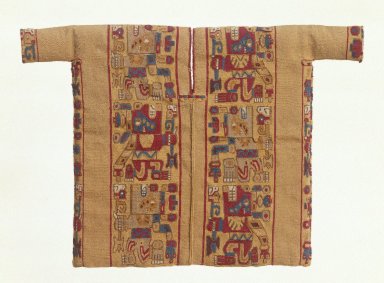
Artist:Wari
Medium: Cotton, camelid fiber
Geograhical Locations:
Dates:500–800
Dimensions: 8 11/16 x 12 1/2 in. (22.1 x 31.8 cm)
Collections:
Exhibitions:
Accession Number: 71.180
Image: 71.180_SL1.jpg,
Catalogue Description: Miniature tunic in single interlock tapestry weave with cotton warps and camelid weft. The thread count is more than 200 threads per inch. This miniature garment with short sleeves was probably a ceremonial textile placed in the tomb of an important personage. The sleeves are too narrow for it to have served as a child's garment. The tunic is decorated with two vertical panels on the front and two on the back that contain composite figures in the act of running. Each figure has a human body, a puma head with condor feathers, and carries a staff terminating in a condor head. The figures are tan, red, blue, yellow, white, purple, and brown on a yellow ground. The remaining parts of the shirt are simple tan panels with red stripes as well as a border at each side containing condor motifs. There is an embroidered rectangular section at the neck. The garment is moderately unstable due to age-related deterioration. Both cotton and camelid fibers have thinned and dried with age. The weaving is very fine and is a visible reminder of how important the person who owned this tunic must have been in Wari society, which was centered in southern Peru. The imagery on this textile relates very closely to the carvings found on the Gateway of the Sun at Tiwanaku near Lake Titicaca in Bolivia. It is not precisely known how the imagery migrated to the Wari Empire and it is difficult to discern as no textiles were preserved at Tiwanaku where the climate is inhospitable for perishable items such as cloth.